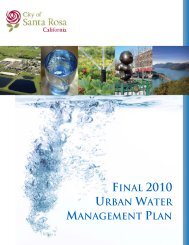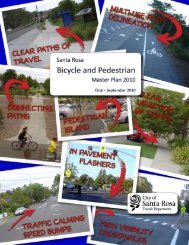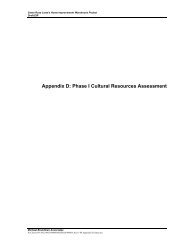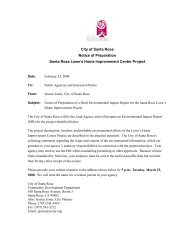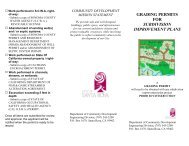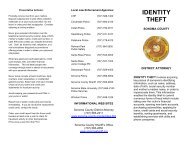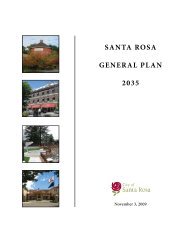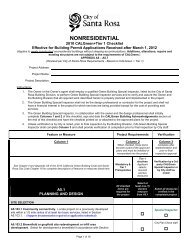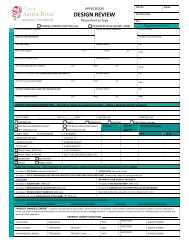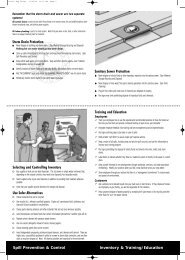Fountaingrove Environmental Impact Report - City of Santa Rosa ...
Fountaingrove Environmental Impact Report - City of Santa Rosa ...
Fountaingrove Environmental Impact Report - City of Santa Rosa ...
Create successful ePaper yourself
Turn your PDF publications into a flip-book with our unique Google optimized e-Paper software.
4.0 MITIGATION MONITORING AND REPORTING PROGRAM<br />
TABLE 4-1<br />
Mitigation Monitoring and <strong>Report</strong>ing Program<br />
Documentation<br />
Additional Permit<br />
Enforcement<br />
Implementation<br />
Schedule<br />
Building Permits.<br />
<strong>Impact</strong>s Mitigation Measures Responsible<br />
Party<br />
MMRP sign<strong>of</strong>f on the fencing <strong>of</strong>f <strong>of</strong><br />
sensitive trees’ root-protection zone.<br />
<strong>Rosa</strong> Public<br />
Works<br />
Department<br />
tree that has a diameter <strong>of</strong> 6 inches or greater, as<br />
measured 4.5 feet above the ground.<br />
Project plans designating construction<br />
staging areas and prohibition <strong>of</strong><br />
parking, loading, and grading during<br />
construction activities within root zones<br />
<strong>of</strong> trees.<br />
Prior to<br />
commencement<br />
<strong>of</strong> any onsite or<br />
<strong>of</strong>fsite<br />
construction<br />
activities.<br />
BMPs shall be included in the plans and specifications for<br />
the Project. These shall be reviewed in pre-construction<br />
meetings with <strong>City</strong> staff, the <strong>City</strong>’s contractor, and<br />
qualified biologists and shall, at a minimum, include the<br />
following provisions:<br />
Meeting Minutes from<br />
<strong>City</strong>/biologist/contractor meeting to<br />
review BMPs.<br />
MMRP sign-<strong>of</strong>f on routing drainage<br />
swales and underground work outside<br />
the dripline where possible.<br />
MMRP sign-<strong>of</strong>f on the placement <strong>of</strong> a<br />
4-inch layer <strong>of</strong> chipped bark mulch over<br />
the soil surface within the fenced<br />
dripline.<br />
MMRP sign-<strong>of</strong>f on pruning to clean and<br />
raise canopy per International Society<br />
<strong>of</strong> Arboriculture pruning standards, if<br />
necessary.<br />
Root protection zone maps,<br />
accompanied by documentation <strong>of</strong><br />
other specific measures.<br />
• Construction drawings shall accurately locate areas<br />
to be avoided such as tree trunks and root<br />
protection zones.<br />
• Before construction, the root-protection zone<br />
(1.5 times the canopy area) <strong>of</strong> sensitive trees shall<br />
be fenced using wire mesh fencing.<br />
• Construction staging areas shall be designated on<br />
plans and prohibit parking, loading, and grading<br />
during construction activities within root zones <strong>of</strong><br />
trees.<br />
• A pre-construction meeting conference shall be held<br />
with contractors to review BMPs and require<br />
bonding and fines to secure the replacement <strong>of</strong><br />
inadvertently damaged trees.<br />
• Existing grade shall be maintained within the fenced<br />
portion <strong>of</strong> the dripline. Drainage swales and<br />
underground work shall be routed outside the<br />
dripline where possible.<br />
• A 4-inch layer <strong>of</strong> chipped bark mulch shall be placed<br />
over the soil surface within the fenced dripline prior<br />
to installing temporary fencing. Suitable mulch must<br />
contain bark “fines.” This layer <strong>of</strong> mulch shall be<br />
maintained throughout construction.<br />
• If pruning is necessary, pruning shall be done to<br />
clean and raise canopy per International Society <strong>of</strong><br />
Arboriculture pruning standards.<br />
• A tree specialist shall be consulted during design to<br />
accurately locate root protection zones and identify<br />
other specific measures that would limit potential<br />
indirect impacts on trees that may be encroached<br />
upon.<br />
• A drainage plan shall be designed that will avoid oak<br />
trees to be preserved.<br />
Project drainage plan.<br />
Construction schedule.<br />
California Fish and Game<br />
Code.<br />
<strong>City</strong> <strong>of</strong> <strong>Santa</strong><br />
<strong>Rosa</strong><br />
Department <strong>of</strong><br />
Community<br />
Development<br />
Mitigation Measure 3.4-3: Provide protection <strong>of</strong><br />
nesting raptors, migratory birds, and nesting<br />
non-special-status birds.<br />
<strong>Impact</strong> 3.4-3: The Project would result in the loss <strong>of</strong> raptor and migratory bird nesting habitat<br />
and could result in impacts to nesting non-special-status birds.<br />
Avian Species Survey <strong>Report</strong>.<br />
Prior to<br />
commencement<br />
<strong>of</strong> any onsite<br />
construction<br />
activities.<br />
Several measures would be implemented to minimize<br />
impacts to nesting raptors, migratory birds, and nesting<br />
non-special-status birds:<br />
Qualified<br />
Biologist<br />
• To avoid impacts to nesting avian species, Project<br />
activity shall be avoided to the degree feasible<br />
during the breeding season (generally, March 1<br />
through September 15).<br />
• If avoidance <strong>of</strong> Project activity during the nesting<br />
season is not feasible, pre-construction surveys for<br />
avian species shall be conducted by a qualified<br />
biologist to identify active nests within or adjacent to<br />
the project site. To the extent feasible, avoidance or<br />
mitigation guidelines from U. S. Fish and Wildlife<br />
Service (USFWS), California Department <strong>of</strong> Fish<br />
4-6 ES092008001PHX\ BAO\082970001<br />
The Project would result in the loss <strong>of</strong> individual trees potentially used for nesting by raptors<br />
and migratory birds. In addition, suitable nesting habitat for many other non-special-status<br />
bird species is present, and construction activities in the Project site may affect these<br />
species. Disturbance <strong>of</strong> nest sites could result in abandonment <strong>of</strong> eggs or young or actual<br />
destruction <strong>of</strong> nests. These impacts are potentially significant. However, most birds such as<br />
observed on the Project site have large home ranges, and existing adjacent habitat could<br />
provide alternative habitat during Project construction.



